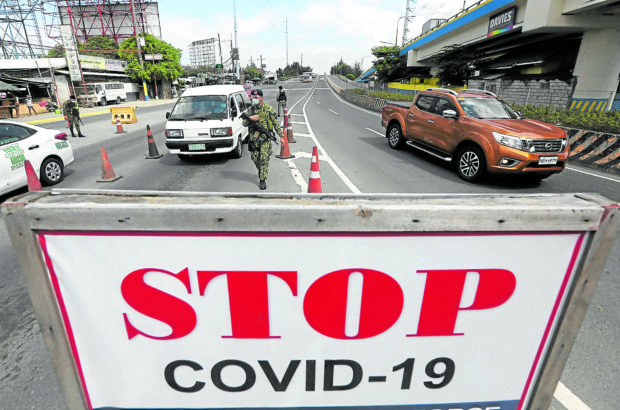OCTA sees weekly uptrend in Metro Manila COVID-19 cases

In this photo taken on March 22, policemen guard the boundary of Cavite and Metro Manila as the national capital and its nearby provinces are placed under lockdown due to a surge in COVID-19 cases. INQUIRER file photo / MARIANNE BERMUDEZ
MANILA, Philippines — The OCTA Research group on Monday reported a rising trend in the weekly average of new COVID-19 cases in the National Capital Region, or a 47 percent increase between July 19 and 25 compared to the previous week.
During the period, there was an average of 954 new cases, compared to 651 from July 12 to 18, the group said. Among the areas with the highest number of new cases were Quezon City (from 116 to 161), Manila (93 to 140), Makati (65 to 89), Taguig (46 to 57), Las Piñas (42 to 51), Valenzuela (28 to 50), Caloocan (37 to 50) and Parañaque (45 to 47).
Critical, high risk
Although OCTA Research did not mention a reason for the increase, it said in an earlier statement that this could be due to the more contagious Delta variant.
The group likewise flagged Cagayan de Oro City and Mariveles in Bataan as being at critical risk, while the cities of Davao, Cebu, Makati, Iloilo, Lapu-Lapu, Laoag, General Santos, Mandaue, Baguio, Las Piñas and Valenzuela were at high risk, based on the weekly case reproduction rate and new daily cases per 100,000 population.
Dominant strains
A health official said the three variants of concern that emerged late last year had become the dominant strains in the country and were likely behind the growing number of COVID-19 cases in some areas.
Article continues after this advertisementIn a press briefing, Health Undersecretary Maria Rosario Vergeire said that of the 9,351 random COVID-19 samples analyzed by the University of the Philippines-Philippine Genome Center since the start of the year, 21.5 percent were of the Beta variant first detected in South Africa.
Article continues after this advertisementThe Alpha variant from the United Kingdom accounted for 19 percent while the Delta variant first flagged in India was discovered in 1.2 percent of the samples.
“One of the objectives of doing whole genome sequencing is for us to determine the root cause or causes why cases suddenly increased or why there is a sustained increase in the number of cases,” Vergeire said.
“And we have proven that in some areas in the country, the variants of concern have been a contributing factor,” she added.
1 percent hike
Vergeire also reported a 1 percent increase in COVID-19 cases nationwide between July 11 and 24 compared to the previous two-week period.
According to her, six regions went from a negative to a positive two-week growth rate, namely, Metro Manila, Cagayan Valley, Central Luzon, Calabarzon, Central Visayas and Northern Mindanao.
“We are seeing clustering of cases for these different regions. But we are not saying that this is due to the variants of concern,” Vergeire said.
Vaccines still effective
After a fully vaccinated priest who reportedly died of a heart attack on Saturday was found positive for the coronavirus, a medical expert assured the public that vaccines remain effective against severe COVID-19 and death.
“In general, severe COVID and death… [are] very rare among [the] fully vaccinated compared to [the] unvaccinated. But among the fully vaccinated who do die, it’s usually because they have [a comorbidity]…. Meaning, COVID didn’t kill them, but it may have worsened the underlying [health] problem,” Dr. Edsel Salvana said.
Salvana, an adviser to the government on pandemic response initiatives, also said that with breakthrough infections—cases of people who contract COVID-19 despite two vaccine doses—most patients remain asymptomatic or develop only mild symptoms.
A postmortem swab test found Fr. Manuel Jadraque Jr.—who was believed to have died of cardiac arrest—positive for COVID-19. But Catholic Bishops’ Conference of the Philippines president Bishop Pablo David said the 58-year-old priest was fully vaccinated. (See related story on this page.) In a text message, Salvana said a heart attack could happen “whether or not” a person was infected with the coronavirus.
“It doesn’t mean COVID caused [the heart attack] but we do know that COVID can more likely [cause a blood] clot,” he added.
To support his assertion that vaccines work, Salvana referred to a recent report from the Philippine General Hospital (PGH) which showed that out of 6,052 fully vaccinated personnel, only 23 contracted the virus.
As for breakthrough cases, there were four (out of 26 new infections) reported in May and 19 (out of 28 new infections) in June.
Most of the workers in the hospital had been inoculated with either Sinovac or AstraZeneca.
“This shows the vaccine is effective although it may not [give] 100 percent [protection]…. More importantly, it protected our [health workers] from having severe COVID-19 and/or dying from the disease,” PGH spokesperson Dr. Jonas del Rosario said in a separate post.
COVID cases update
On Monday, there were 6,664 new COVID-19 cases reported in the country, pushing the total detected cases to 1,555,396.
The Department of Health (DOH) said there were 23 additional deaths, including 17 who had been tagged as recoveries, bringing the total COVID-19 death toll to 27,247.
On the other hand, 5,766 more people recovered from the disease for a total of 1,473,009 recoveries although 55,140 others remained infected.
Of the active cases, 93.6 percent were mild; 1.1 percent, asymptomatic; 1.61 percent, moderate; 2.3 percent, severe and 1.4 percent, critical.